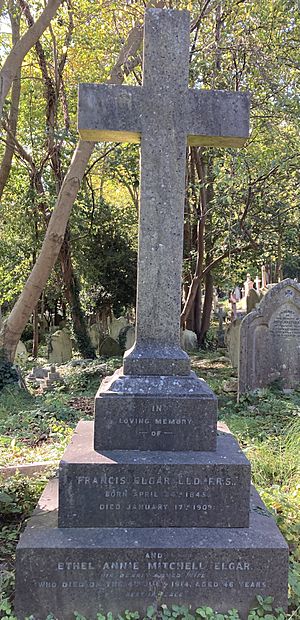Francis Elgar facts for kids
Quick facts for kids
Francis Elgar
|
|
|---|---|
| Born | 24 April 1845 |
| Died | 17 January 1909 |
| Alma mater | Glasgow University |
| Occupation | Naval architect |
Prof Francis Elgar (1845 – 17 January 1909) was a very important naval architect. This means he was an expert in designing and building ships. He was born in Portsmouth on April 24, 1845. His father, Francis Ancell Elgar, worked at the Portsmouth dockyard.
Contents
A Young Ship Designer
When Francis Elgar was 14, he started training as a shipbuilder at the Portsmouth dockyard. He also went to a special school there for apprentices. He was so good that he won a scholarship for more advanced learning.
In 1864, the Royal School of Naval Architecture and Marine Engineering opened in London. Francis Elgar was one of only eight students chosen to study naval architecture there. He finished his three-year course in 1867 with the highest diploma. He even helped publish the school's 'Annual' magazine.
From 1867 to 1871, Elgar worked for the shipbuilding department of the royal navy. He worked in different dockyards and private shipyards.
Becoming a Top Expert
In 1871, Elgar left the public service. He became the main assistant to Sir Edward James Reed, a famous naval architect in London. Elgar also helped Reed write for a magazine called 'Naval Science'.
Building and Advising Ships
From 1874 to 1876, Elgar was the general manager of Earle's Shipbuilding in Hull. After that, he worked as a naval architect in London.
From 1879 to 1881, he went to Japan. There, he advised the Japanese government on how to build their navy ships.
When he returned to London in 1881, he continued his private work. He advised big shipping companies on how to design new ships. He also investigated why important ships were lost or had accidents.
Solving Ship Safety Problems
Francis Elgar became a leading expert on how stable merchant ships were. He wrote reports on two famous ship accidents:
- The Austral, which sank in Sydney harbor in 1881.
- The Daphne, which tipped over when it was being launched in 1883.
In 1883, Elgar joined a special committee. Their work helped create new laws and rules for setting the maximum "load-line" for ships. The load-line is a mark on a ship that shows how much cargo it can safely carry. These rules helped make shipping much safer.
Teaching and Leading Shipyards
In 1883, Francis Elgar became the first professor of naval architecture at a university. This new program was started at Glasgow University. Even though he could still do private work, Elgar spent most of his time setting up this new school. Many students came to study there because of his great reputation.
Director of Dockyards
In 1886, the admiralty (the government department in charge of the navy) asked Elgar to return to public service. He became the Director of Dockyards, a brand new job. For six years, he made the dockyards work much more efficiently and quickly.
Leading Fairfield Shipbuilding
In 1892, he left his job as Director of Dockyards. He then became a consulting naval architect and director of the Fairfield Shipbuilding and Engineering Company in Glasgow. This company was very important in shipbuilding.
Under Elgar's leadership, Fairfield grew and improved. They designed and built new types of ships, like fast torpedo-boat destroyers and speedy cross-Channel steamers. They also started using new technologies early on, such as steam turbines and water-tube boilers, which worked very well.
Later Career and Legacy
In 1908, Elgar decided to retire from Fairfield to rest. However, friends asked him to help reorganize another company, Cammell, Laird & Co.. This company built ships and made steel. Soon after, he also became chairman of Fairfield. His hard work helped these companies succeed, but it was very tiring for him.
Francis Elgar was known for combining scientific knowledge with practical business skills. He received many honors:
- He was given an honorary law degree (LL.D.) from Glasgow University in 1885.
- He became a Fellow of the Royal Society of Edinburgh (FRSE) and later a Fellow of the Royal Society (FRS) in London in 1895.
He wrote many important papers about ship design, stability, and strength. He was a long-time member of the Institution of Naval Architects and the Institution of Civil Engineers. He also served on the council of the Royal Society of Arts.
Francis Elgar died suddenly in Monte Carlo on January 17, 1909. He was buried in Highgate Cemetery in London.
Family
In 1889, Francis Elgar married Ethel Colls. They did not have any children.
Legacy
Francis Elgar cared deeply about education. He started a scholarship to help students study naval architecture at the Institution of Naval Architects. He also left large gifts in his will to the Institution of Naval Architects and the naval architecture department at Glasgow University.
In 2022, he was honored by being inducted into the Scottish Engineering Hall of Fame.


